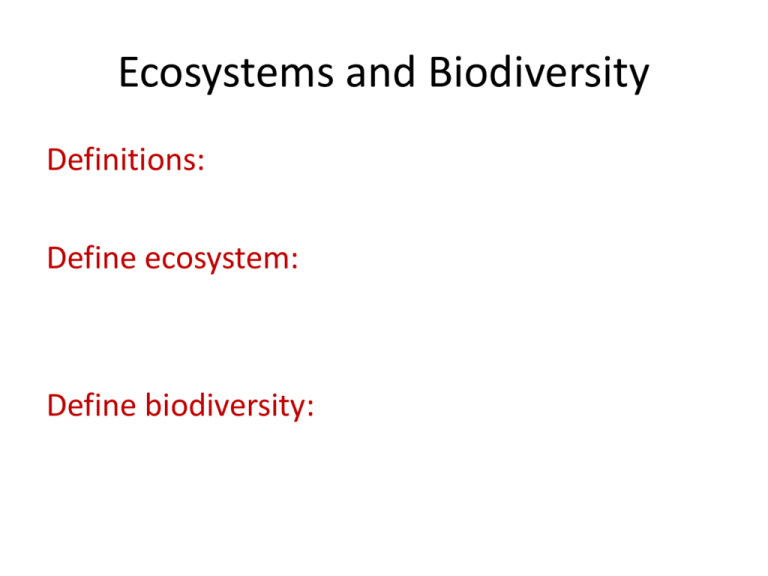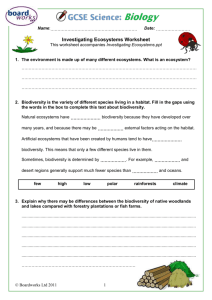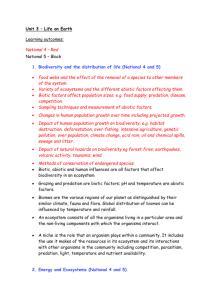Bug Lyphe - KBS GK12 Project
advertisement

Ecosystems and Biodiversity Definitions: Define ecosystem: Define biodiversity: Ecosystems and Biodiversity Definitions: Define ecosystem: a biological community of interacting organisms (biotic) and their physical environment (abiotic) Define biodiversity: the variety of life in a particular habitat or ecosystem Ecosystems and Biodiversity Definitions: Define ecosystem: a biological community of Not necessarily just interacting organisms (biotic) and their number of types, but physical environment (abiotic) evenness of those types as well! Define biodiversity: the variety of life in a particular habitat or ecosystem Ecosystems and Biodiversity: Leading Questions How might ecosystems vary in abiotic (non-living) properties or conditions? How can abiotic conditions affect biodiversity? How can abiotic conditions be altered? Ecosystems and Biodiversity: Leading Questions How might ecosystems vary in abiotic (non-living) properties or conditions? How can abiotic conditions affect biodiversity? How can abiotic conditions be altered? Ecosystems and Biodiversity: Leading Questions How might ecosystems vary in abiotic (non-living) properties or conditions? How can abiotic conditions affect biodiversity? How can abiotic conditions be altered? Ecosystems and Biodiversity: Leading Questions How might ecosystems vary in abiotic (non-living) properties or conditions? How can abiotic conditions affect biodiversity? How can abiotic conditions be altered? Ecosystems and Biodiversity: Leading Questions Why might biodiversity be important? Ecosystems and Biodiversity: Leading Questions Why might biodiversity be important? • Ecosystem functions – – – – food, fiber, energy Air and water purification Pollination and seed dispersal Ecotourism and recreation • The “insurance hypothesis” – With more species or groups, ecosystems are more likely to maintain function even if some fail due to disturbance, disease, invasion, etc… – Resilience to change – Stability Making this a classroom activity Use the habitat types (“ecosystems”) surrounding your own schools to sample for biodiversity of invertebrates, and specifically insects. The BEST plots can also work here! Making this a classroom activity • Modify number of different habitat types and sampling methods to your choosing • Incorporate concepts of randomization, replication, etc… Sampling for Biodiversity • Use different habitat or ecosystem types near your school to sample for biodiversity • Potential habitat types: forests (primary vs. successional), yard, parking lot, wetland, grassland or prairie • Encourage students to make hypotheses beforehand – Which habitat type do you expect to see the most insects overall? – In which habitat type do you expects to see the greatest number of orders? Sampling Method: Sticky Traps • Refer to BEST plot protocols • http://kbsgk12project.kbs.msu.edu/blog/2011 /09/14/biomass-and-biodiversity-protocols/ Sampling Method: Pit Traps • Refer to BEST plot protocols • http://kbsgk12project.kbs.msu.edu/blog/2011 /09/14/biomass-and-biodiversity-protocols/ Sampling Method: Sweepnetting • Refer to optional BEST plot protocols • http://kbsgk12project.kbs.msu.edu/blog/2011 /09/14/biomass-and-biodiversity-protocols/ Sampling Method: Pan traps (pollinator cups) • Meant to simulate the colors of flowers • Paint bowls or cups different colors to encourage pollinators to visit – Red, yellow, blue, white • Fills bowls or cups with soapy water to trap insects • Set out (randomly) in habitat patch • Collect after one day Sampling Method: Berlese Funnels • Useful for sampling insects from litter (leaves) and top layer or soil • Use a hand trowel to remove litter and top ½ inch of soil from a predefined area (5 in x 5 in, for example, but adjust to fit funnels) • Place into a modified Berlese funnel (leaves first) and shine light directly over leaves to drive insects into container of ethanol Invertebrate ID Resources • “What Bug Is That?” poster • KBS GK-12 “Invertebrate Guide” powerpoint – Click here • Bugguide.net • Dichotomous Key for Winged Insects – Click here • Dichotomous Key for Wingless (or TinyWinged) Insects – Click here Image from bugguide.net Working with the data • Shannon-Weaver diversity index – Takes counts and relative abundance into consideration – Can be done by hand – Excel sheet can be used to calculate ShannonWeaver diversity index using student-generated data Working with the data • Shannon-Weaver diversity index – Takes counts and relative abundance into consideration – Can be done by hand – Excel sheet can be used to calculate ShannonWeaver diversity index using student-generated data Working with the data • Graphing Activities – Students can choose to graph an interesting pattern of their choosing – Examples: • Graph abundance of one order across multiple habitat types • Graph abundances of various orders within one habitat type • Graph Shannon-Weaver diversity index across habitat types Follow-up Questions 1. Human activities can deliberately or inadvertently alter the equilibrium in ecosystems. How did human activity affect the different ecosystems that we measured? 2. Your data shows a difference in carrying capacities for the differing ecosystems. Describe the factors that affect carrying capacity in each of the habitats that you measured insect diversity in. 3. In general, what are the benefits of having high levels of biodiversity in any ecosystem? 4. How do highly diverse insect populations and communities benefit humans? 5. Was there a difference in the types of insect orders found in the various types of traps? What trends did you notice?







